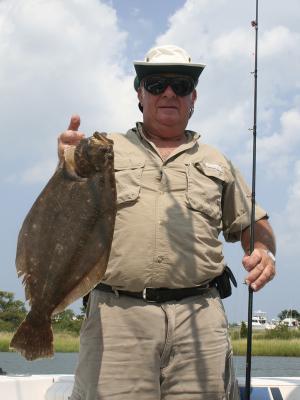Flounder size limit lowered for 2014
Finally, some good news for Delaware recreational fishermen. The Atlantic States Marine Fisheries Commission has decided to try managing summer flounder on a regional basis. In a move that I understand made at least one of the New Jersey delegates quite upset, the commission decided to put Delaware in the same region as Virginia and Maryland. As a result, our size limit will drop to 16 inches for 2014.
This left New Jersey and New York in the same region, lowering New York’s minimum size to 18 inches and raising New Jersey’s to the same standard. Had Delaware been placed in with New Jersey and New York, our limit would have been raised, while our good neighbors to the north would have seen their minimum size lowered.
I do feel sorry for New Jersey fishermen who have been stuck with a higher size limit, but all requests by Delaware to New Jersey over the past 50 years or longer to cooperate with us and set comparable regulations in the Delaware Bay have fallen on deaf ears. This time, the regulations were set by a coast-wide forum that realized Delaware’s flounder size and disbursement are more closely related to Maryland and Virginia than to New Jersey and New York.
Tagging studies and trawl surveys have shown that summer flounder spawn in the ocean, then move into the estuaries to grow. After the first two years, these fish join the coastal spawning stock and spend the winter along the Continental Shelf. In the spring, flounder return to the inshore coastal waters and bays, but when they do, the majority of the larger fish move north. That leaves the southern states with the younger, smaller fish while the bigger fish populate northern waters. In the past, New York has seen size limits as high as 21 inches, so an 18-inch limit in 2014 will be a real break.
It is possible for Delaware to exceed its quota for 2014, since we will have a one-inch lower minimum size while retaining the four-fish bag limit. If this occurs, we will have to make up the overage during the 2015 season.
There are a few reasons why I don’t believe this will happen. The flounder fishing in 2013 was very poor for those who fished the shallow waters of the inland bays and tidal rivers. The problem was not a lack of fish in excess of the 17-inch minimum size, but an overall lack of flounder. Since the vast majority of flounder fishermen work these waters, and since there is no indication that a larger number of fish are likely to be there in 2014, I believe we will catch a few more fish, but not enough to put us over the quota.
Anglers working the ocean reef sites, wrecks and rough bottom had the most success with flounder last year. Compared with the number of small boats fishing the inland bays and tidal rivers, the larger ocean-going boats represent a small minority. The 16-inch minimum size will allow those anglers to limit out early, and four fish are four fish no matter the size.
One other benefit to the 16-inch size limit is fishermen who work from head boats may be inclined to fish out of Delaware rather than New Jersey where the limit will be 17 inches. Should this occur it will be a real benefit for the Bowers Beach head boat fleet that has suffered through larger size limits and a blocked channel for the past few years.
It is my understanding that this regulation regimen could change before flounder return, but probably will not. It is only in effect for one year, and then the system will be evaluated before any changes are made for 2015.
Trout season
It may be hard to believe with every pond in Delaware sporting a covering of ice, but freshwater trout season will open in Sussex and Kent counties in two weeks. Tidbury Pond in Kent County and Newton Pond in Sussex County are currently closed to all fishing while the state stocks trout prior to opening day Saturday, March 1.
Delaware resident anglers between 16 and 64 will need their Delaware general fishing license and Delaware trout stamp in order to fish in these ponds once the season opens. Those of us who have seen our 65th birthday in the rearview mirror need only a fisherman identification number. I still buy a trout stamp since the money collected goes directly into the next year’s trout program. Young folks between 12 and 15 years of age will need a young angler trout stamp at a cost of $2.10.
Nonresident fishermen 16 and over will need a nonresident general fishing license and a nonresident trout stamp. Those between 12 and 15 will need the nonresident trout stamp at a cost of $6.20.























































